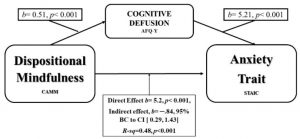Less Negative Emotions Occur in Mindful Children and Adolescents
By John M. de Castro, Ph.D.
“We ultimately want to give children (and teens, and adults!) the ability to notice however they feel in the moment, and the tools to manage and respond appropriately to their inner and outer experience.” – Oren Jay Sofer
Childhood and adolescence are times of mental, physical, social, and emotional growth. But they can be difficult times, fraught with challenges. During these times the individual transitions from childhood to young adulthood; including the development of intellectual, psychological, physical, and social abilities and characteristics. There are so many changes occurring during these times that the child can feel overwhelmed and unable to cope with all that is required. This can heighten negative emotions and anxiety. Indeed, up to a quarter of adolescents suffer from depression or anxiety disorders, and an even larger proportion struggle with subclinical symptoms.
Mindfulness training in adults has been shown to reduce anxiety, depression, and perceived stress levels and improve emotional regulation. In addition, in adolescents it has been shown to improve emotion regulation and to benefit the psychological and emotional health. On the other hand, getting lost in thought (mind wandering) has been shown to be associated with negative emotions. Hence, there is a need to explore the relationship between mindfulness, getting lost in thought, and emotions in children and adolescents.
In today’s Research News article “Cognitive Fusion Mediates the Relationship between Dispositional Mindfulness and Negative Affects: A Study in a Sample of Spanish Children and Adolescent School Students.” (See summary below or view the full text of the study at: https://www.ncbi.nlm.nih.gov/pmc/articles/PMC6926870/), García-Gómez and colleagues recruited children and adolescents between the ages of 8 to 16 years. They were measured for cognitive fusion, experiential avoidance, mindfulness, positive and negative emotions, and anxiety.
They found that the higher the levels of mindfulness the lower the levels of cognitive fusion, experiential avoidance, negative emotions, and anxiety. A mediation analysis revealed that mindfulness had both direct and indirect associations such that mindfulness was negatively associated directly with both negative emotions and anxiety and also indirectly by way of its negative association with cognitive fusion which was in turn negatively associated with negative emotions and anxiety. Higher levels of mindfulness were associated with lower levels of cognitive fusion which, in turn, were associated with lower levels of negative emotions and anxiety.
These results are correlational and thus causation cannot be determined. Also, this study employed only children and adolescents, So, it is not established if similar findings would occur in adults. But there are a large number of studies that demonstrate a causal effect of mindfulness on negative emotions and anxiety with adults. Indeed, in the present study, age did not moderate the results. Hence the present results probably are due to the effects of mindfulness on cognitive fusion and on these negative emotions and occur regardless of age.
“Cognitive fusion is a process by which the individual becomes entangled with memories, thoughts, judgments, and evaluations and adjust behavior to the internal experiences.” Hence cognitive fusion is the antithesis of mindfulness. One cannot be mindful and at the same time be lost in thoughts. This suggests that being lost in thought (cognitive fusion) tends to produce negative emotions, while being mindful tends to reduce these negative emotions. This suggests that mindfulness by focusing the individual on the present moment improves the individual’s emotional state and also tends to prevent getting lost in thought which also improves the individual’s emotional state.
So, reduce getting lost in thought and negative emotions with mindfulness.
“When I look at childhood anxiety I see an enormous problem and a precursor to other problems in adolescents and adults,” – Randye Semple
CMCS – Center for Mindfulness and Contemplative Studies
This and other Contemplative Studies posts are also available on Google+ https://plus.google.com/106784388191201299496/posts and on Twitter @MindfulResearch
Study Summary
García-Gómez, M., Guerra, J., López-Ramos, V. M., & Mestre, J. M. (2019). Cognitive Fusion Mediates the Relationship between Dispositional Mindfulness and Negative Affects: A Study in a Sample of Spanish Children and Adolescent School Students. International journal of environmental research and public health, 16(23), 4687. doi:10.3390/ijerph16234687
Abstract
Nowadays, mindfulness-based interventions (MBI) have experienced a remarkable development of studies among childhood and adolescent interventions. For this reason, dispositional mindfulness (DM) measures for children and adolescents have been developed to determine the effectiveness of MBI at this age stage. However, little is known about how key elements of DM (for example, cognitive de/fusion or experiential avoidance that both confirm psychological inflexibility) are involved in the mechanisms of the children and adolescents’ mental health outcomes. This research examined the mediating effect of cognitive fusion between DM and anxiety and other negative emotional states in a sample of 318 Spanish primary-school students (aged between 8 and 16 years, M = 11.24, SD = 2.19, 50.8% males). Participants completed the AFQ-Y (Avoidance and Fusion Questionnaire for youth), which is a measure of psychological inflexibility that encompasses cognitive defusion and experiential avoidance; CAMM (DM for children and adolescents), PANAS-N (positive and negative affect measure for children, Spanish version of PANASC), and STAIC (an anxiety measure for children). The study accomplished ethical standards. As MBI relevant literature has suggested, cognitive defusion was a significant mediator between DM and symptoms of both negative emotions and anxiety in children and adolescents. However, experiential avoidance did not show any significant mediating relationship. Probably, an improvement of the assessment of experiential avoidance is needed. MBI programs for children and adolescents may include more activities for reducing effects of the cognitive defusion on their emotional distress.
https://www.ncbi.nlm.nih.gov/pmc/articles/PMC6926870/
